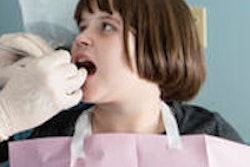
The U.S. Preventive Services Task Force (USPSTF) has issued its final recommendation statement for primary care providers outlining dental caries prevention for children until they reach 5 years of age.
Two of the three major points made in the document focus on providing fluoride access. The last item, however, explained that "the Task Force concludes that the current evidence is insufficient to assess the balance of benefits and harms of routine screening examinations for dental caries performed by primary care clinicians in children from birth to age 5 years."
Published online in Pediatrics (May 5, 2014), the document updates the last set of recommendations the USPSTF made in 2004; it similarly recommended fluoride supplements to children who did not receive fluoride in their tap water, without mentioning varnish treatment for erupted teeth, according to an article by dailyRx.com.
“Discuss your child's risk factors ... and whether your child is already seeing a dentist.”
The new recommendations are aimed at primary care clinicians or primary care providers -- such as physicians or nurse practitioners -- who are nondental healthcare professionals. Consequently, the research the organization sourced when preparing its recommendations focused wholly on primary care settings.
For example, while noting that risk assessment tools exist and typically encompass factors such as family oral health history, fluoride exposure, dietary habits, and oral hygiene practices, "the USPSTF found no studies that evaluated the accuracy of risk assessment instruments for future caries in the primary care setting."
The organization's purpose is to improve the health of Americans by providing evidence-based recommendations on clinical preventive and counseling services, screenings, or medicines. Its independent volunteer panel members are made up of prevention and evidence-based medicine experts with national reputations, according to the USPSTF's website.
The first recommendation is that children who do not receive sufficient fluoride via their drinking water begin taking oral supplements in the form of drops, tablets, or lozenges, for example, at 6 months of age. The second recommendation states that primary care physicians should begin applying fluoride varnish to the primary teeth of all children as soon as their first tooth appears.
While the topic of fluorosis is mentioned, the panel concluded that risks for it from fluoride varnish are minimal. The child's "overall systemic exposure to fluoride from multiple sources" should be considered, "but in the U.S., enamel fluorosis presents as mild cosmetic changes in >99% of cases," the panel added.
Having noted that, both of these recommendations received a B rating on an A through D scale, in which A gets the highest recommendation, C recommendations depend on the patient's situation, and D is not recommended.
The last of the three major points in the recommendations received an I statement, indicating insufficient evidence "to say whether having primary care clinicians regularly screen children for dental caries by examining their teeth improves children's future health," the USPSTF stated.
Interestingly, while the panel noted that the recommendations are designed for those providing general healthcare, no mention of a dental home is made, nor did it indicate that it sought out research exploring a connection between oral health and visits to a dentist through 5 years of age.
The panel sought out caries risk-assessment tools, noting that they are useful in gathering data about demographic risk, fluoride exposure, oral hygiene routines, family history, dietary habits, or other measures such as oral bacterial load. Its search, limited to the primary care setting, found "no studies that evaluated the accuracy of risk assessment instruments for future dental caries," the panel noted.
The topics of dental visits and caries risk were covered by the panel outside of its primary recommendations. "Discuss your child's risk factors for tooth decay and whether your child is already seeing a dentist" with his or her primary care physician, the USPSTF advised.



















